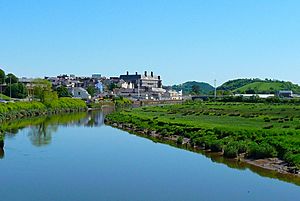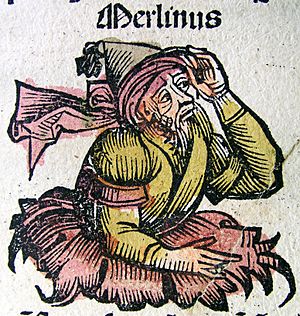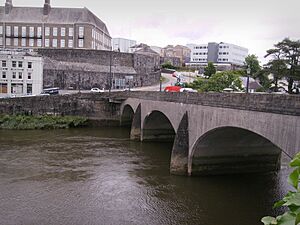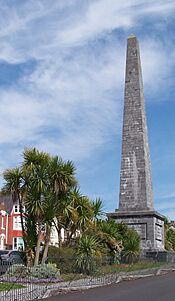Carmarthen facts for kids
Quick facts for kids Carmarthen
|
|
|---|---|
 |
|
| Population | 14,636 (Community, 2021) 16,455 (Built up area, 2021) |
| OS grid reference | SN415205 |
| Community |
|
| Principal area | |
| Ceremonial county | |
| Country | Wales |
| Sovereign state | United Kingdom |
| Post town | CARMARTHEN |
| Postcode district | SA31-33 |
| Dialling code | 01267 |
| Police | Dyfed-Powys |
| Fire | Mid and West Wales |
| Ambulance | Welsh |
| EU Parliament | Wales |
| UK Parliament |
|
| Welsh Assembly |
|
Carmarthen (which is Caerfyrddin in Welsh) is a historic town in Wales. It is the main town of Carmarthenshire county and sits on the River Towy, about 8 miles (13 km) from where the river meets the sea. In 2021, the town had a population of around 14,636 people.
Carmarthen is thought to be the oldest town in Wales. It was built on the site of an old Roman town. In the Middle Ages, there were actually two settlements: Old Carmarthen and New Carmarthen. These two parts joined together in 1546. For a long time, Carmarthen was the biggest town in Wales.
Contents
History of Carmarthen
Ancient Times
When Britain was part of the Roman Empire, Carmarthen was called Moridunum, which means "Sea Fort". It was the main town for a local tribe called the Demetae. The Roman fort here was likely built around 75 AD. Near the fort, there is one of only seven Roman amphitheatres left in Britain. An amphitheatre was like a stadium where people watched shows and events.
Some historians think Carmarthen might be the "Fort Vortigern" mentioned in an old book called History of the Britons. Digs have shown that a Roman town existed here from the 2nd century.
Middle Ages
During the Middle Ages, the town was known as Llanteulyddog. Because Carmarthen was in an important location, the Normans built a castle here around 1094. The castle was destroyed by Llywelyn the Great in 1215 but was rebuilt in 1223. This is when Carmarthen became one of the first towns in Wales to have walls. In 1405, the castle was captured by Owain Glyndŵr.
The terrible disease known as the Black Death arrived in Carmarthen between 1347 and 1349. It spread through the busy river trade and caused a lot of devastation.
Religious Buildings
In 1110, an old church called Llandeulyddog became a Benedictine priory (a type of monastery). Later, it became an Augustinian priory, which was a religious community. Its remains can still be seen today.
Franciscan friars, also known as Grey Friars, also came to Carmarthen in the 13th century. They built their own friary (another type of religious house) in Lammas Street. The Franciscans believed in living simply. Many important people were buried there, including Edmund Tudor, 1st Earl of Richmond, who was the father of the future King Henry VII.
The friary was closed down in 1538 during the time of King Henry VIII. Over time, the buildings fell into ruin. Today, a shopping centre stands on the site.
Merlin and Legends
The famous wizard Merlin from the King Arthur legends is said to have been born in a cave near Carmarthen. The Welsh name for the town, Caerfyrddin, is often said to mean "Merlin's fort". Some people think the name Merlin might actually come from the town's name, or that Myrddin (the Welsh name for Merlin) is a changed version of the Roman name Moridunum, meaning "sea fort".
There's also a local legend about a tree called Merlin's Oak. The legend says that if this tree ever fell, it would bring down the town. To prevent this, when the tree died, it was dug up. Pieces of it are now kept in the town museum.
Later History
One of the earliest Eisteddfodau (a Welsh festival of literature, music, and performance) took place in Carmarthen around 1451.
In the 16th and 17th centuries, Carmarthen was mainly an agricultural town. It was also known for making wool. After Wales became part of the English legal system, Carmarthen became an important legal centre for southwest Wales.
During the 1550s, a Protestant leader named Bishop Ferrar was executed in the market square. A small plaque now marks this spot.
In the 18th century, some small factories started in Carmarthen, including an ironworks and a place for smelting lead. A printing press was set up in 1840 by William Spurrell, who wrote a history of the town and created Welsh-English dictionaries.
Carmarthen was also important in the Chartist movement, which was a working-class movement fighting for political rights in the 1830s. In 1843, the workhouse in Carmarthen was attacked during the Rebecca Riots, a series of protests against unfair taxes.
The National Eisteddfod has been held in Carmarthen several times, including in 1867, 1911, and 1974.
During World War II, prisoner-of-war camps were located near Carmarthen. Defensive lines with ditches and pill boxes (small concrete bunkers) were also built around the town in case of an invasion.
Carmarthen was named one of the best places to live in Wales in 2017.
How Carmarthen is Governed
Carmarthen has two levels of local government. The Carmarthen Town Council looks after local matters in the town. It is based at St Peter's Civic Hall. The Carmarthenshire County Council manages services for the wider county. Its main office, County Hall, is located on Castle Hill, on the site of the old Carmarthen Castle.
Carmarthen has a long history of self-governance. From 1536 until 1832, the town had its own Member of Parliament (MP). Today, Carmarthen is part of the Caerfyrddin parliamentary area, which elects an MP to the UK Parliament.
Weather in Carmarthen
| Climate data for Carmarthen (1991–2020) | |||||||||||||
|---|---|---|---|---|---|---|---|---|---|---|---|---|---|
| Month | Jan | Feb | Mar | Apr | May | Jun | Jul | Aug | Sep | Oct | Nov | Dec | Year |
| Mean daily maximum °C (°F) | 8.6 (47.5) |
9.1 (48.4) |
10.9 (51.6) |
14.0 (57.2) |
16.9 (62.4) |
19.3 (66.7) |
21.0 (69.8) |
20.6 (69.1) |
18.2 (64.8) |
14.9 (58.8) |
11.5 (52.7) |
9.1 (48.4) |
14.5 (58.1) |
| Mean daily minimum °C (°F) | 2.1 (35.8) |
2.1 (35.8) |
3.0 (37.4) |
4.7 (40.5) |
7.3 (45.1) |
10.0 (50.0) |
11.9 (53.4) |
11.2 (52.2) |
9.7 (49.5) |
7.2 (45.0) |
4.2 (39.6) |
2.3 (36.1) |
6.3 (43.3) |
| Average rainfall mm (inches) | 139.2 (5.48) |
116.8 (4.60) |
93.0 (3.66) |
77.3 (3.04) |
74.4 (2.93) |
79.2 (3.12) |
74.4 (2.93) |
117.8 (4.64) |
114.5 (4.51) |
155.2 (6.11) |
148.2 (5.83) |
155.8 (6.13) |
1,345.8 (52.98) |
| Mean monthly sunshine hours | 55.4 | 80.8 | 122.6 | 183.8 | 211.6 | 202.8 | 194.9 | 172.4 | 137.1 | 103.8 | 67.3 | 50.1 | 1,582.6 |
| Source: Met Office | |||||||||||||
Places of Worship
Churches
St Peter's Church is the largest parish church in the Diocese of St David's. It is a very old building, made of local red sandstone. It became a Grade I listed building in 1954, meaning it is very important historically.
As the town grew, St Peter's became too small. So, two new churches were built: St David's (consecrated in 1841) and Christ Church (opened in 1869).
Carmarthen also has a Catholic church, St Mary's.
Chapels
Carmarthen has several important nonconformist chapels, some of which are very old. These include Baptist chapels like Tabernacle, Penuel, and the English Baptist Church.
Lammas Street Chapel is the town's oldest Congregational chapel, dating back to 1726. Other chapels like Priory Chapel and Bethania Chapel also have long histories in the town.
Famous Landmarks
Carmarthen Castle
Not much of the original medieval castle remains today, but the old Gatehouse is still a very noticeable landmark in Nott Square. You can also visit the castle mound, called a motte. Inside the old castle walls, Castle House now serves as a museum and a Tourist Information Centre.
Carmarthen Bridge
The main road bridge over the River Tywi was finished in 1937. It was designed by a Welsh architect named Clough Williams-Ellis. This modern concrete bridge replaced a much older medieval bridge.
Pont King Morgan
To make it easier for people to walk from the train station to the town centre, a special pedestrian bridge called Pont King Morgan was built in 2005. This bridge cost £2.8 million and connects to Blue Street. Before this, people had to walk much further to cross the main Carmarthen Bridge.
Picton's Monument
In 1828, a monument was built to honour Lieutenant General Sir Thomas Picton, a soldier who died in the Battle of Waterloo in 1815. The first monument was very tall, like a column. However, it became damaged and was taken down.
A new monument to Picton was built in 1847 on Monument Hill. In 1984, the top part was removed because it was unsafe, but the whole monument was rebuilt a few years later. Recently, there have been discussions about the monument due to Picton's historical actions.
General Nott Statue
A statue of General Nott was put up in 1851. This bronze statue was made from cannons captured in a battle. It stands where the old market cross used to be.
Below General Nott's statue, there is a small plaque. It remembers Bishop Robert Ferrar, who was a Protestant leader burned at the stake in this very spot in March 1555.
Other Important Buildings
Carmarthen has many listed buildings, which means they are historically important. These include the Carmarthen Guildhall, various chapels like Capel Heol Awst, and churches such as Christ Church and Eglwys Dewi Sant.
Town Facilities
Carmarthen is home to the main office for the Dyfed–Powys Police (the local police force). It also has Glangwili General Hospital and a campus of the University of Wales Trinity Saint David.
A new shopping centre opened in 2010 on the site of the old cattle market. It has a cinema, a market hall, restaurants, and a multi-storey car park.
Getting Around
Roads
Several main roads meet in Carmarthen, including the A40, A48, A484, and A485. The M4 motorway, which connects South Wales to London, ends near Carmarthen.
Railway
Carmarthen railway station opened in 1852. You can catch trains from here to places like Cardiff Central and Swansea to the east, and to towns like Fishguard Harbour and Milford Haven to the west. There are also direct trains to London.
Buses
Local bus services connect Carmarthen with nearby towns like Aberystwyth, Cardiff, and Llanelli. There is also a Park and Ride service that runs from outside the town into the centre. Long-distance coaches also stop in Carmarthen, connecting it to cities like Birmingham and London.
Sports in Carmarthen
Carmarthen has two rugby union teams: Carmarthen Quins and Carmarthen Athletic. There's also a rugby league club called CPC Bears.
The town's football team, Carmarthen Town F.C., plays in the Cymru South league. They play their home games at Richmond Park. The team's colours are gold and black. There is also a youth football team called Carmarthen Stars.
Carmarthen has two golf courses, a leisure centre with a swimming pool, an athletics track, and a cycle track. The town also has an athletics team called Carmarthen Harriers.
Picton Barracks
Picton Barracks is a military installation located in the west of Carmarthen. It is used by the Ministry of Defence. Some military units based here include parts of the Royal Logistic Corps and the Royal Electrical and Mechanical Engineers (both Army Reserve units). The Air Training Corps also has a squadron here.
Famous People from Carmarthen
Many notable people have connections to Carmarthen, including:
- Joe Allen (born 1990), a famous football player for Wales and Swansea City FC.
- Mark Drakeford (born 1954), a Welsh politician and former First Minister of Wales.
- Dave Evans, the original lead singer of the rock band AC/DC.
- Rhod Gilbert (born 1968), a well-known television host and comedian.
- Stephen Jones (born 1977), a former captain of the Wales rugby team.
- Iwan Rheon (born 1985), an actor famous for his role in Game of Thrones.
- Matthew Stevens (born 1977), a professional snooker player.
Twin Towns
Carmarthen is twinned with several towns in other countries, which means they have special friendly relationships:
- Lesneven, in Brittany, France
- Santa Marinella, in Italy
- As Pontes, in Galicia, Spain
Images for kids
See also
 In Spanish: Carmarthen para niños
In Spanish: Carmarthen para niños














